By Nathan G. Briggs, M.S.
Fly Pests
Have flies been bothering your livestock? Fly control can help keep cattle happy, healthy, and productive.
Fly Identification
In order to put fly mitigation steps in place, identifying the type of fly or flies bothering your livestock is a key step. The environment that livestock are in can indicate the type of fly pressure that could be present. The two main environments for cattle are in barns and on pasture.
In barns, the two main flies that bother livestock are house flies and stable flies. House flies (Figure 1) breed in manure piles, animal droppings, decaying silage, spilled feed, bedding, and in other organic matter, and it takes them about 10 days under optimal conditions for them to become an adult and start reproducing. A female house fly can live for 10 to 30 days, produce 150 to 200 eggs, and spread diseases and parasites to cattle. During the summer months, house flies can be spotted on cattle and cause annoyance. House flies do not bite.
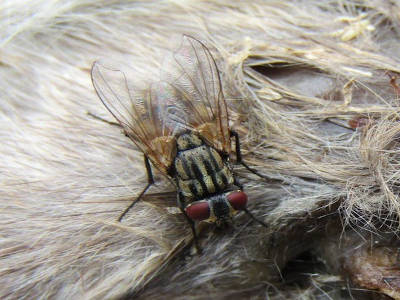
Stable flies (Figure 2) will breed in wet straw, manure, spilled feeds, decaying silage, grass clippings, and various other decaying vegetation. Stable flies take 21 days to mature into a reproductive adult. Females generally live for 20 to 30 days, where they produce 200 to 300 eggs. Stable flies will feed on one to two drops of blood several times a day, which causes a production performance loss. Livestock will stomp their feet because stable flies localize around the legs and belly of the animal. These flies are primarily a nuisance during the warm summer months. Calves raised in confinement are very susceptible to this fly.
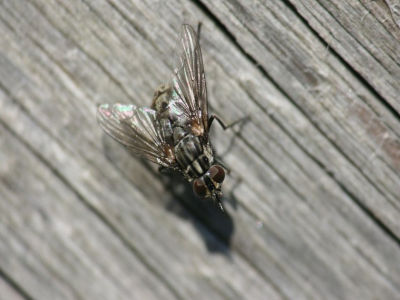
In pasture systems, a few common fly pests are horn flies, face flies, horse, and deer flies. Horn flies (Figure 3) feast on 20 or more blood meals every day on the shoulders, sides, and backs of cattle. On hot or rainy days, horn flies will move to the underside of the belly. Horn flies will mature to a reproductive adult in 10 to 20 days. Females will lay eggs in fresh droppings that are less than 10 minutes old. The flies will survive winter in dung packs to continue their lifecycle when temperatures are warm. Horn flies decrease milk production, reduce weight gain, cause blood loss, and fatigue. Chemical controls are generally required to control horn flies.
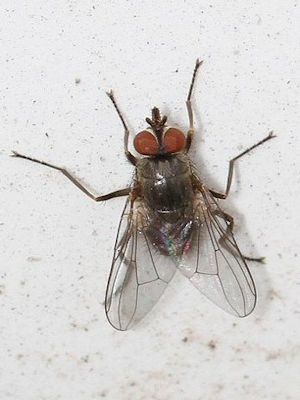
Face flies (Figure 4) are non-biting but can vector diseases. As the name indicates, face flies are most active around the face and eyes. Pinkeye and eyeworms are diseases that can be spread through the herd, due to face fly infestation. Although face flies are non-biting, they are facultative blood feeders, which means they will consume blood meals from blood left behind by another fly. Face flies will complete their lifecycle in 2 to 3 weeks and can travel several miles to find a host. Male face flies do not swarm faces of livestock and are not a nuisance. Face flies will not enter darkened barns during the summer, but they will enter barns to protect themselves from the cold in the winter. Fresh manure piles are their location of choice for egg laying.
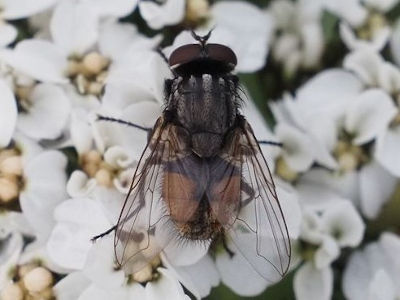
Horse (Figures 5 and 6) and deer flies (Figure 7) consist of over 300 individual species, and they will inflict pain and severe annoyance to the animal. They feast on blood, then leave blood pools behind that attract face flies. Large numbers of horse and deer flies can result in extreme annoyance, fatigue, blood loss, decreased milk production, and decreased weight gain. Tularemia, anthrax, anaplasmosis, and leukosis are all diseases that can result from large populations of horse and deer flies. Females will lay eggs near marshes, ponds, and streams, poorly drained pastures and the offspring can take 70 days to 2 years to develop. The best control method is to remove livestock from pastures bordering wet areas. Another method is to time grazing wet regions around the rainy season. Special traps for Horse flies can be deployed in pastures.
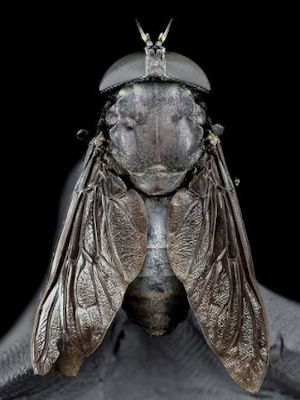
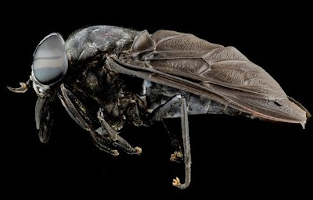
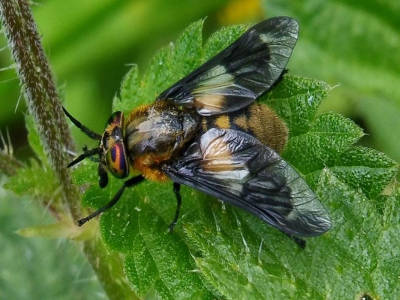
Integrated Pest Management
An integrated pest management (IPM) plan should be utilized to sustainably reduce fly populations below the economic threshold. Integrated pest management combines cultural, biological, and chemical means for fly mitigation.
Cultural
Cultural forms of pest management alter the environment that the pest would normally thrive in. For example, frequently removing manure and spoiled feed, combined with reducing moisture in barns can reduce house and stable fly populations. If composting manure fits into your operation, then making one to two turns in your compost will provide multiple heat cycles that kill flies and prevent reproduction. A clean barn can also help to reduce the exposure to potential pathogens that would make animals sick. Since high moisture content of manure makes for prime fly breeding, controlling water content of manure piles is important. This may include the use of manure storage areas on the farm or tarping piles. These methods would be cultural ways of controlling fly infestations.
Biological
The biological role in IPM is to have predatory insects kill and consume the flies, eggs, and/or larvae depending on the species released. A commonly used method in barns would be to release parasitic wasps weekly or biweekly in areas around the barn depending on total fly pressure. With some internet ordering services, the producer can set up a reoccurring delivery of parasitic wasps for the duration of fly season (summer months). To have an effective release of parasitic wasps, the package that the parasitic wasps arrive in should be opened near piles of manure or any other potential heavy fly breeding grounds.
Chemical
The last method involved with IPM is chemical control, or the use of chemicals to kill pests. This can include ear tags, feed additives, larvicides, baits, rubs, bags, residual premise, whole animal (pour-on), space sprays, and building treatments. Insecticides should be used as a last resort for fly control, because insecticides can potentially harm beneficial insects, such as dung beetles and parasitic wasps. When insecticides are applied, all naturally occurring or purposely released insects will be killed too. A common chemical used for fly control is pyrethrin, because it kills insects immediately upon contact. This is a chemical that is derived from the pyrethrum daisy. Pyrethroids are synthetic, or not naturally occurring compounds that have been created to imitate pyrethrin. An example of a pyrethroid would be permethrin. Unfortunate naming has made these chemicals easily confused with one another. Organic operations can use products listed on the OMRI website, which includes many pyrethrum daisy-based products. Some restrictions may apply.
Feed additive insecticides pass through the animal and remain in the manure. When fly larvae develop, they consume the larvicide and die. This method can be effective if all animals in a couple mile radius are on the product. If there are other livestock nearby that are not using the product, then flies could drift to your animals and still be a pest. Feed-troughs and other chemical methods of control should be set into a rotation based on the active chemical ingredient. Using this rotation, pest resistance to chemical treatments can be prevented or delayed over time. Some products can negatively affect beneficial organisms, such as Figure 8, that breakdown manure patties naturally, which reduces fly populations due to manure patties spreading out and drying quicker.
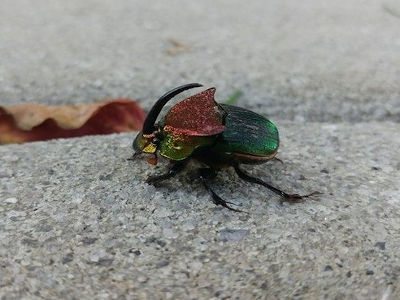
Although not normally listed in fly IPM, a mechanical method for fly removal is pulling every fly off the animal. A vacuum is used to suck flies into a vacuum system that collect the flies in a removable bag for disposal. This method has a high initial investment and takes some time to get cattle used to running through the chute but helps alleviate the need for chemical sprays and insect resistance. High velocity fans used during summer heat also helps keep flies off cattle in feedlots; however, coverage in most buildings is not uniform so other methods must be added.
Conclusion
In conclusion, identify the flies that are being pests to cattle and know the life cycle to best manage fly populations. The best method of control is a combination of control strategies known as integrated pest management. Combine cultural, biological, and chemical methods to have the most effective fly control strategy. Whether your operation is organic or conventional, one control method is seldom a sustainable option. Each livestock owner needs to chart an IPM strategy that controls fly populations and is cost-effective for their operation.
Source : psu.edu